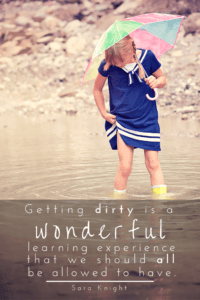Book Review: Risk and Adventure in Early Years Outdoor Play
[sc name=”Disclosure”]
Taking risks is a key part of growing up, one that many kids these days are missing out on. They are never out of sight from an adult, they are plucked from the top of playground equipment before they have a chance to think about how to get down, they certainly don’t climb trees. Wrapped up in cotton wool, they enter adulthood without having had a chance to test their mettle, to push themselves, to fail and then try again. Supporting our kids in taking risks is something that every parent should be mindful of.

Wanting to make myself more aware of risk-taking for young children, I picked up Risk and Adventure in Early Years Outdoor Play (affiliate link)by Sarah Knight. Drawing largely from her experience with forest schools, Knight makes the case for children to engage in risk while supported by adults, and gives practical examples. The book goes through several outdoor elements (water, earth, wind, fire, seasons) and points out the risks while emphasizing the benefits to the child. She includes sections on assessing risk as well as the role of the adult in managing risk.
I found the book very thought provoking. If I wasn’t certain that allowing my child to take risks was a positive thing, then I would certainly have been convinced by the end of the book. She emphasizes that while adults in charge need to be mindful of the risks a child might encounter, and reasonable precautions taken, it is safer in the long run to introduce children to risks and help them learn to navigate them on their own. There are also many practical examples of her practice in forest schools that could be easily applied at home, such as preparing children for an open fire by playing with a pretend fire until you observe that they follow your instructions and mind the rules that you have put into place for everyone’s safety.
If I found the book lacking, it is in places where I was hoping for very specific instruction, such as teaching children to use tools, or developing an understanding of when to intervene in children’s play or risk-taking. This is, though, beyond what Knight set out to do in the book, which, by her own admission, is designed for people to use with only a basic knowledge of the outdoors. She does have an excellent list of resources available in the book for further information, and I’m looking forward to investigating that list.
Overall, I would recommend this book for parents or practitioners who want to be more confident of the benefits of adventurous play and risk-taking for young children, or who want to recognize opportunities for these activities outdoors more easily.
Buy Risk and Adventure in Early Years Outdoor Play on Amazon (affiliate link).


